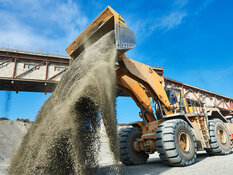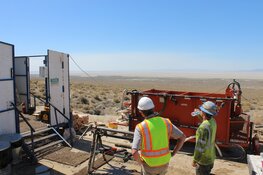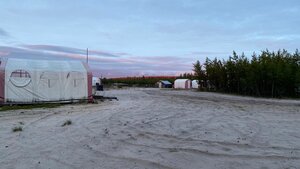Bob Moriarty: Anyone who wants to verify this should search Google for a chart of population growth compared to oil production. The two are identical from about 1850 on. Here's why: it takes so many calories of fuel to produce so many calories of food. It's direct, linear and absolute. If the price of fuel doubles tomorrow, how much more or less driving would you do?
TER: Less, but I would still have to drive. I could not eliminate it.
BM: Would you eat more food or less food?
TER: I could eat less given the price.
BM: Everyone else in the world feels the same way. The majority of people in the world survive on $2 worth of food each day. But how do you eat less when you are on the edge of starvation in the beginning? There has been a 70% increase in the price of wheat since June. That's catastrophic.
I believe that peak oil, or the peak of oil production, occurred back in 2005 or 2006. Peak oil means peak food, which means peak population. We're going to consume less fuel per capita 20 years from now because there's simply no alternative. In turn, that means the population is going to decrease. It could decrease through starvation, disease, war or all three.
TER: In the same article, you said there are other ways that people might be able to produce more food with the same amount of fuel. Besides decreases in population, another outcome could be that less oil would drive more innovation in food production.
BM: That's the real point of the article—there are things that people can do. Potash is used to make fertilizer. As food gets more valuable, potash gets more valuable. It's not necessarily that you're more efficient in the production of food. If the price of wheat doubles, farmers can afford twice as much potash. It's not necessarily more efficient; it's just cheaper in relative terms.
TER: Besides wheat, other food commodities have recently increased dramatically in price. Potash has already risen quite a bit in cost. Looking forward, is there still a lot of upside for potash as a fertilizer component?
BM: Absolutely, because the price of food is going to go higher and higher. Potash is around $600/ton now, but it could be $1,500/ton based on the cost of food today.
TER: If the price of potash increases, do you anticipate that more juniors and explorers will be exploring for potash?
BM: That's the way supply and demand is supposed to work. When uranium went from $8/lb. to $136/lb., there were 450 companies out there exploring for it. Now that doesn't mean they'll be successful.
TER: You were a very early investor in Passport Potash Inc. (TSX.V:PPI, OTCQX:PPRTF). But, ironically, you sold your Amazon Mining (TSX.V:AMZ) shares after the company abandoned gold-mining plans for potash.
BM: Amazon had a gold project in the Amazon. I was hoping the company would get into production. Shares at the time were around $0.09. The company made the decision to go into potash. Potash was not particularly popular then, and I thought they were making a mistake. I wanted to see them advance the gold project and get it into production. So, I sold all my shares. Well, everybody in the universe discovered potash at the same time. Amazon Potash is an $8 stock now. I should've hung on to the stock. That was a very expensive mistake on my part.
TER: What about Passport changed your mind about potash?
BM: Someone presented the Passport story to me about two-and-a-half years ago. It had a big land position in Holbrook Basin, Arizona. I bought into it. Potash was about $900/ton back then. The stock went up to around $0.22.
The company came to a point at which it had squandered all its money. Fortunately, the company found a deep-pockets investor. The investor thought that it sounded like a pretty easy deal, and asked what the company needed to succeed. They said, "We need a check for $750,000 right now so we can go drill." They did drill and it was successful. The investor was buying shares at a nickel each. The stock was around $1 two weeks ago. He made a ton of money in it.
TER: What do you see in the future for Passport?
BM: The company has a strong management team. More importantly, it has access to capital as never before. It has a serious investor, who is prepared to put more money into it. As long as Passport keeps succeeding, he's going to keep throwing money at it.
TER: How much more upside is there?
BM: Several dollars a share. This could be a $1 billion company in two to three years.
TER: It sounds like we could be heading into a potash bubble.
BM: Most companies are going to fail. You have to be counter-cyclical. Potash was way too cheap. Companies couldn't afford to mine it profitably, and now it will overshoot in the other direction. I hope there is a bubble. That will be a tremendous opportunity to get out at a giant profit. We're not at the top for potash, but everything goes up and everything goes down.
TER: For investors who want to capitalize on potash, what companies represent good assets in the ground and viable long-term prospects?
BM: Western Potash Corp. (TSX.V:WPX) has been around for years, but it just keeps moving forward. Its stock has gone from $0.36 in August to $1.80 this year.
TER: What caused it to go up fourfold since August?
BM: The second round of quantitative easing by the Fed, QE2. When they announce QE3, you better head for your bunker.
TER: If QE2 is what's lifting these equities, why wouldn't we expect the same from the third round for these strategic commodities?
BM: If you keep blowing into a balloon, sooner or later, it's going to pop. As bad as QE1 was, I was staggered when Fed chairman Ben Bernanke came up with QE2. We've got riots all over the world including in Wisconsin, and he's sitting there saying it doesn't have anything to do with him. Well, it has everything to do with him.
There is room for maybe 10 rare earth producers. There's room for maybe five graphite producers. There's room for 500 gold and silver producers. But there's room for every company that wants to produce potash. There are a lot of people who don't believe in gold, silver, rare earths or graphite, but they all eat.
TER: You mentioned graphite. Is that going to be one of the metals to watch?
BM: I'm trying to put together a deal right now on a project in Quebec that would be the best graphite company in the world. About 90% of the graphite in the world comes out of China. Graphite, or carbon fiber, is more prevalent in a lithium battery than lithium. While there are probably about 100 companies that claim to focus on lithium, there are only three or four companies that claim to focus on graphite. Graphite is a commodity with enormous potential. However, it's got marketing issues. The reason for that is something called Say's Law, which says that supply creates demand. We could use a lot more graphite. We need to be using a lot more graphite.
People in the mining business don't know how to sell. They worry about resources, but they don't think about the end product.
TER: If the mining industry was better able to understand the broad base usage for graphite, could they create exponential demand for the product?
BM: Correct. The total demand worldwide for graphite right now is 1 million tons per year. Think about it: 1 million tons per year for an iron or coal producer is chump change.
TER: Given some of uses for graphite, such as creating lighter cars and planes, wouldn't the engineers of those products be clamoring to find the graphite?
BM: They know they need it, but they don't go out and say, "Let's go mine some graphite!" They just pay more money for it. Graphite costs about $20,000/ton at the wholesale level.
TER: In a recent article on 321Energy.com, you made an observation that "there are over 75 new reactors being planned in China, India and Russia. Peak oil is both real and past. We need nuclear power, and the rest of the world understands that, and is preparing for $200 oil." This echoes statements that were made in 2007 before the uranium boom busted. What's different now?
BM: If a commodity goes from $8/lb. to $136/lb., you should not be looking for it to go to $250/lb. You should be looking for it to go to $30/lb. No commodity goes straight up and no commodity goes straight down. Corrections are important. Uranium has had its correction and now it's moving higher. It's around $63 a pound right now and no one cares.
TER: How has the situation in Japan impacted the nuclear sector?
BM: Japan does things right. What happened in Japan was a 10 sigma event and could not be foreseen. It literally comes under the "Stuff Happens" rule, but it's going to pretty much wipe out the ability for uranium juniors to raise money for years. Underfunded juniors in the uranium field better go find a real job.
That said, we still need nuclear and we still need uranium to feed existing plants. Regulators will be far stiffer in permitting, but there is no viable alternative to nuclear. Solar power and wind power are 3% solutions and that's all they will ever be. Carbon-based energy just got a lot more valuable. This is going to set nuclear back for years.
TER: What uranium companies are you looking at now?
BM: American Energy Fields Inc. (OTCBB:AEFI) in Phoenix is doing some pretty good stuff. The company wants to get into production on past-production mines. I believe it has a resource at about 30 million pounds right now. The company shares management with Passport, as well as its deep-pocket investor. The two companies are run out of the same office.
TER: Is American Energy's uranium play more interesting to you because of the Passport connection? Or would it stand on its own if it had a different management team?
BM: I was familiar with the company six months ago. I went out to see it about a month ago, and management started going over how many projects they have and how close they were to production. I said, "Holy cow!" These guys have been a big secret. Nobody's heard anything about them.
We do some pretty unusual things. We will go to management and tell them they have to improve their website, for example. I don't know anybody else who has the gall to do that. I told them I wouldn't write a piece about them until they changed their website. So, they did it.
TER: Does that management team run any other companies besides American Fields and Passport?
BM: They're putting together some rare-earth deals and a gold deal, but they're still tentative.
TER: Bob, I appreciate your time.
Convinced that gold and silver were at a bottom, and wanting to give others a foundation for investing in resource stocks, Bob and Barb Moriarty brought 321gold.com to the Internet almost 10 years ago, and later added 321energy.com to cover oil, natural gas, gasoline, coal, solar, wind and nuclear energy. Both sites feature articles, editorial opinions, pricing figures and updates on the current events affecting both sectors. Before his Internet career, Moriarty was a Marine F-4B and O-1 pilot with more than 820 missions in Vietnam. A captain at age 22, he was one of the most highly decorated pilots in the war and the youngest naval aviator in Vietnam. He holds 14 international aviation records, and once flew an airplane through the Eiffel Tower's pillars "just for fun."
Want to read more exclusive Energy Report interviews like this? Sign up for our free e-newsletter, and you'll learn when new articles have been published. To see a list of recent interviews with industry analysts and commentators, visit our Expert Insights page.
DISCLOSURE:
1) Karen Roche of The Energy Report conducted this interview. She personally and/or her family own shares of the following companies mentioned in this interview: None.
2) The following companies mentioned in the interview are sponsors of The Energy Report: Passport Potash, Amazon and American Energy Fields.
3) Bob Moriarty: I personally and/or my family own shares of the following companies mentioned in this interview: Passport and American Energy Fields. I personally and/or my family am paid by the following companies mentioned in this interview: None.












































